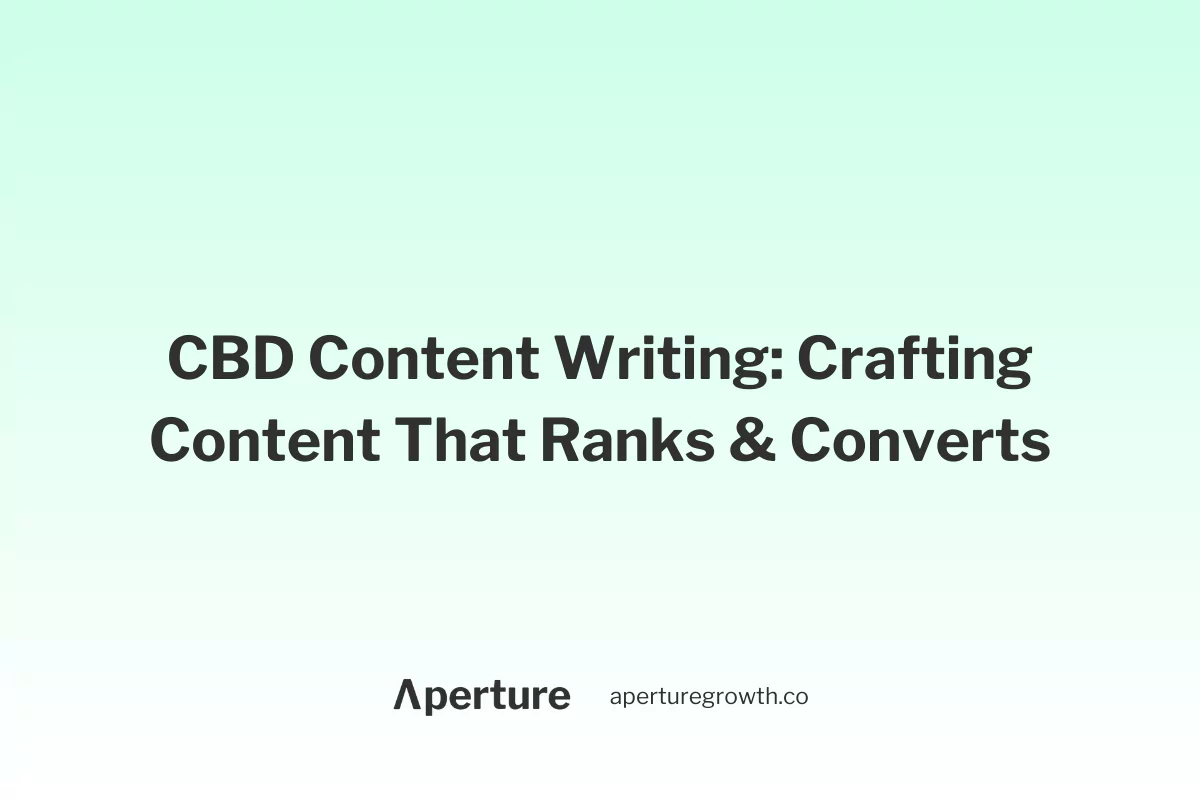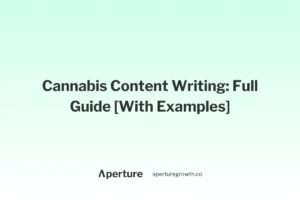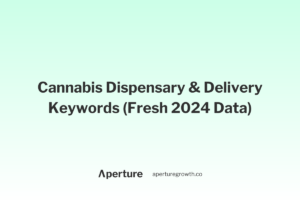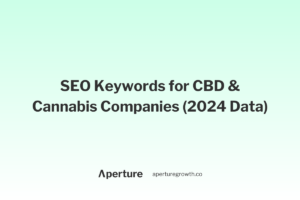CBD content writing is the best way to drive more website traffic and sales for your brand – but only if you do it right.
That’s why, in this article, I’m going to show you how to write blog content that ranks on Google and drives revenue for your CBD brand.
No vague generalities: this is the exact process we use at our agency to drive hundreds of thousands of clicks and sales every year for our SEO clients. I hope it helps you, too – let’s get into it.
What is CBD Content Writing?
CBD content writing is the practice of planning, developing, and publishing written material for your CBD brand, such as articles, blog posts, and product descriptions, with the purpose being to engage your target audience and accomplish some specific objective with them.
For the sake of this article, I’ll focus exclusively on writing SEO-focused blog content, as that’s the type of content writing that CBD brands invest the most in due to its game-changing returns (again, if done right).
Why is CBD Content Writing Important?
There are four main benefits of writing blog content for your CBD brand: two related to SEO, and two related to long-form content as a medium to engage your customers.
Content can drive organic traffic, email signups, and sales
If you write blog content on topics relevant to your audience that meets the search intent behind the queries you’re targeting, you can rank on Google and drive organic traffic for your CBD brand.
With a pop-up form in place, you can use this traffic to build your email list. Some of this traffic may also convert to sales – again, assuming your content maps to the products you sell – although most of your sales will come from your transaction-focused pages.
I regularly see CBD brands driving hundreds of email signups and thousands in sales each month from their blog. While driving direct sales isn’t the primary reason to write blog content (as you’ll see in a second), it’s a significant side benefit.
Though SEO-focused content writing can drive email signups and some direct sales, the biggest benefit it offers is topical authority. Let me explain.
CBD SEO strategy revolves around getting your category and product pages to rank. These are the pages where people buy products, and if you can rank them for search terms that indicate someone is shopping for what you sell, you can make boatloads of money.
CBD local SEO strategy revolves around ranking your Google Business Profile in the Map Pack, and your location pages in the regular results, for location-related terms. If you can rank for these terms, your business will receive more foot traffic.
Blog content helps by building authority for your site on the topics that map to your products, which helps these lucrative pages rank better.
For any query on a given topic, Google prefers to rank pages from sites that are an authority on that topic.
For example, if you want to rank for “CBD gummies,” you must become an authority on this topic.
How do you do that? Write high-quality, SEO-focused content that covers the topic of “CBD gummies” from all the relevant angles.
Topical authority isn’t necessarily an obvious benefit of content, but it’s one of the most important.
Content can fuel your entire marketing engine
If you’re writing high quality content to build your CBD brand’s visibility in organic search, you’ll have plenty of source material to create the other types of marketing content you need:
- Social media posts
- Emails
- Flyers, eBooks, and educational materials
The catch here is that your blog content must be high quality. You can rank (though only temporarily) with basic, bland, uninteresting content.
But if you want to fuel your entire CBD content marketing operation, you must build the content for humans first, then optimize for search engines after.
Content builds trust with customers that paid ads can’t
Along with SEO, paid ads are one of the main options CBD brands have when it comes to acquiring customers online.
Paid ads are hard to execute for CBD brands for many reasons, so SEO is a popular alternative.
But the content side of SEO, specifically, has another benefit: it builds deep trust with prospective customers because it gives you an opportunity to provide value to readers while demonstrating your expertise and credibility.
If your brand is able to speak in-depth about CBD and hemp, back your points up with research, and tie the benefits back to everyday life, your brand becomes more of an authority. And the authority in a space is the default choice in customers’ minds.
In an industry weighted with stigma and questionable products, CBD content writing is a particularly useful marketing tactic.
Steps to Successful CBD Content Writing
We employ an eight-step content writing process at our agency:
- Choose topic
- Perform SERP analysis
- Write headline & build outline
- Research article
- Write first draft
- Edit piece
- Embellish
- Publish
There is no exact formula, because every topic is unique and every piece of content needs to be different to rank organically and provide value.
But following the same basic steps for every article allows you to create something that’s consistently high-quality.
It also makes it easier to hone in on where you’re making mistakes if your content is falling short, whether on quality or SEO performance.
Start by creating a new blank document. Then, dive into the steps below.
Step 1: Choose Topic
The first step is figuring out what to write about. When doing SEO, your topic will be a group of keywords that you want to rank for. However, you’ll format your article to target the head keyword (generally, the highest-volume, most general keyword in the group you’re targeting).
While there are quite a few factors you’ll want to consider when choosing CBD blog topics, at a basic level, any head keyword should meet three criteria:
- Maps to the products you sell (so you’ll build topical authority).
- Has decent monthly search volume – to start, I recommend keywords with 50-100 searches per month starting out (so you’ll get traffic if you rank).
- Has reasonably low competition – to start, I recommend a difficulty score (via an SEO tool) of 30 or under to start (so you can rank in a reasonable time frame).
If you’re trying to build topical authority and grow your organic traffic, you’ll want to write about the topics that map to your product line.
Here’s an example. Let’s say your brand primarily sells CBD. CBD is the main topic.
Ultimately, you might want blog posts that rank for the main subtopics like:
- CBD benefits
- CBD side effects
- CBD vs. THC
But starting out, these keywords will be too difficult to rank for.
So instead, you’ll want to find sub-sub-topics for each main subtopic that are more achievable:
- CBD benefits
- CBD for sciatica
- CBD for flight anxiety
- CBD side effects
- Does CBD make your eyes read?
- Does CBD make your heart race?
- CBD vs. THC
- CBD vs. THC for sleep
- CBD vs. THC for anxiety
By thinking hierarchically, you’ll be able to find easier ranking opportunities that still map directly to your product line and allow you to build topical authority.
I’ll also say that for 99% of brands, it makes no sense to rank for very broad, general keywords. These keywords are typically very hard to rank for and render very few email signups or sales – there are easier ways to build topical authority that make more business sense.
Step 2: Perform SERP Analysis
This is where the magic happens (in my opinion): the search engine result page (SERP) analysis.
Essentially, SERP analysis is the process of reverse-engineering what’s already ranking to determine what you need to include in your article in order to rank.
Here is the exact process I use:
- Do a Google search for the keyword you’re targeting.
- Write down all the subtopics in the titles of the top 10 ranking articles, making tallies next to a subtopic each time it appears.
- Perform a subtopic analysis; click in the Google search bar and see which subtopics Google autocompletes for your keyword (e.g. for the keyword “CBG vs CBD,” Google might autocomplete “CBG vs CBD vs CBN,” “CBG vs CBD for anxiety,” and “CBG vs CBD for pain.”) Write down these autocomplete subtopics in the order they appear.
- Determine which 1-3 search intents to answer, based on which topics appear most often in the titles of the top 10 articles and appear highest in Google autocomplete.
- What subtopics of the main keyword are you going to focus on in your title and content? From the example above, are you going to compare CBG and CBD for anxiety and pain in addition to giving a general comparison? Are you going to compare them to CBN? All three? This is the step where you decide, at a high level, what your article is going to cover.
- Figure out which subtopics are the most important to the topic by reading through the top 5-10 results and writing down all the topics you see covered in the Heading 2 and Heading 3 tags, making a tally for each time a topic appears.
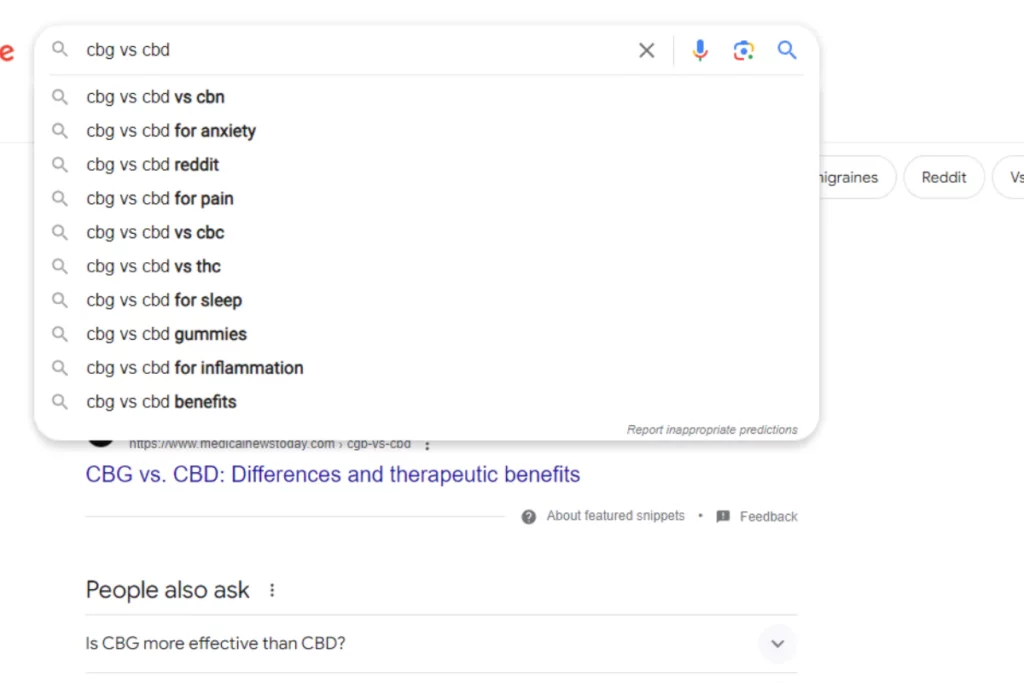
Step 3: Write Headline & Build Outline
Now that you know roughly what your article will cover, and what’s working for other people, it’s time to write your article headline and build your article outline.
For the headline, you’ll want to do three things:
- Include keyword your trying to rank for, or a close variant
- Include the top 1-3 search intents (subtopics)
- Keep it below 60 characters
From the example in step 2, our headline could be, “CBG vs. CBD: Differences & How They Compare to CBN.” This headline includes our main keyword and focuses on the two main intents people have when searching this keyword: learning the difference between these two cannabinoids, and discovering how they compare to CBN.
To build your outline, do the following:
- Highlight all the most frequently-covered subtopics from step 5 of your SERP analysis. These are the topics you’ll need to cover in your article in order for it to rank.
- Write these topics down in the order you’ll cover them in your article.
- Add in additional subtopics, based on the opportunities you see to better fit the search intent of the keyword.
- Convert these topics to Heading 2s in your article; this is your basic outline.
- Add in necessary Heading 3 topics, based on your SERP analysis, common sense, and what you determine would be beneficial to discuss.
- Add a conclusion/takeaways section at the end of your article.
Outline-building tip: Keep is MECE (mutually exclusive, collectively exhaustive). This means that you should cover EVERY subtopic that’s part of your main topic (collectively exhaustive), but that you should not cover ANY subtopic that isn’t a part of your main topic.
Your outline will dictate what you discuss in your article and in what order, so it’s important that it’s both complete and cohesive.
You probably won’t nail your outline 100% the first time. You’ll have to write 10-20 articles (at least) before you begin to get a feel for what should go where and what needs to be included in order for an article to rank for a keyword.
But by using this checklist, you can produce high-performing content far more quickly than if you utilize the hope-and-pray methodology of CBD content writing (aka: using no methodology).
Step 4: Research Article
With your outline built, it’s time to do some research to gather the information that will make up your article.
This way, when it’s time to write, you can focus all of your energy on wordsmithing instead of needing to track down additional data points.
In doing research for CBD articles, I recommend pulling in insights from five main places:
- Subject-matter-expert interviews: If you own or work for a CBD company, you’re already a subject-matter-expert on CBD and related topics. But if you’re writing content for someone else’s CBD company (as we do on a daily basis), you’ll want to interview someone with CBD knowledge for every article you create. This will ensure your article includes unique insights that aren’t available elsewhere, which allows you to provide unique value to your readers and gives you a competitive advantage from an SEO and branding standpoint.
- Scientific journals: If you’re writing about the benefits of CBD or how it works in the body – which you should be in the majority of the articles you create – you’ll need to cite scientific research to back up your points. Find key studies and add the links and key conclusions into your outline. However, ensure that you don’t misrepresent the research, use it to claim CBD is a disease treatment, or use it to claim that CBD can reduce disease symptoms (this is how you get into hot water with the FDA).
- Your other content: If you’re creating groups of articles around each of the topics that correspond to your product lines, every main topic you do an article about will be a subtopic in another of your articles. Add links to related articles, and paste in relevant information from each. Many sections will be re-usable between articles; this saves time and doesn’t diminish the quality of your content.
- Forums and social media platforms: Reddit, Quora, Twitter, and other discussion-based platforms are great sources of anecdotal insights and firsthand experience from real people about your topic. Lots of people share their experiences with CBD products (the r/CBD subreddit has over 150k subscribers); search your topic on these platforms and see if people bring up the same things repeatedly. These insights may be worth mentioning in your article, assuming they aren’t harmful or factually incorrect.
- Other online resources: After you’ve scoured the above four sources to ensure your content is as uniquely valuable as possible, you can turn to other people’s content. But don’t just pull from other blog posts on your topic: add “filetype:pdf” to your search to uncover publicly available PDFs about your topic that most readers (and other brands) don’t know exist.
Step 5: Write First Draft
Now it’s time to tie all of your research together; that’s all CBD content writing really is.
I’ll offer two writing tips (in response to the two most common blogging mistakes I see):
- Put the BLUF: BLUF stands for bottom line up front. People don’t click your content to read a beautiful, flowery intro: they click because they need an answer or an insight, and they’re hoping you can give it to them. So do that – answer the key question (which you should know based on your SERP analysis) in the first few sentences of the article. Use the rest of the article to expand on and give context to that answer.
- Don’t use statistics or research as arguments: Use 3rd-party sources to support your arguments, but ensure your arguments and ideas stand on their own from a logic and coherence standpoint.
Don’t overthink this step; just the first draft done. It won’t even be close to perfect, but that’s what step six is for.
Step 6: Edit
This is where you take your article from good to great.
Be sure to run a spell check to fix easy mistakes before and after your hands-on editing.
Here are a few editing tips to keep in mind:
- Avoid mixing up bullet points and numbered lists: If you say, “here are three things to keep in mind” or similar, be sure to present the information as a numbered list and not a bullet list.
- Avoid introducing each section: Don’t write “in this section, we’ll discuss…” Don’t introduce each section; it’s annoying to read and makes no sense if your article is already structured logically. Instead, get into the content of the section in the first sentence.
- Minimize your use of “more on that later”: This usually means you’re discussing topics out of turn. Sometimes this is necessary, but most of the time it’s not.
- Leave some eye relief: You’re not writing a research paper, you’re writing a blog post. Break up paragraphs of more than three lines (unless they’re in a list) to make your article easier to read.
- Make headings scannable: Add context to your headings so that people are able to easily scan your article and find where their answer is. As an example, if you’re discussing scientific research behind CBD under an H2, and discussing research for different uses in the H3s underneath, say “Research suggests CBD may promote restful sleep” instead of just writing “Sleep.”
You might also want to perform an SEO edit of your article by running it through a tool like SEMrush or Clearscope.
These tools suggest keywords to include in your article based on what’s already ranking, and they’re great at identifying if there’s a certain area where your article is falling short in terms of topic coverage.
Just be sure not to overdo the keyword suggestions to the point that including them begins to diminish the quality of your content.
Step 7: Embellish
After you’ve edited your article into a valuable, easy-to-read resource, improve it further by adding:
- Images and graphics: Ideally, these are custom graphics and images of your products, but at the very least, add a couple of stock photos with your logo or branding to them.
- Calls-to-action (CTAs): Every article must have a CTA somewhere. You can use interstitial CTAs that lead to your category and product pages, or you can provide links in the text throughout that lead to these pages or to other articles on your site. Just be sure that your CTAs map clearly to the content of the article and that you don’t put too many.
Step 8: Publish
Now you can upload your article to your content management system (CMS). But before you hit publish, be sure you do the following:
- Write your SEO title: This is the title that will show up in the search results. Generally, it will be the same as the regular article title, but you may want to change it slightly to improve clickthrough rates. Just be sure to keep it under 60 characters, or it will be cut off.
- Write meta description: This is the text that is displayed just below the title in the search results. To write it, briefly summarize the value someone will get from reading your article (what topics you cover or questions you answer), or, answer the main question. Both work. Keep it under 160 characters.
- Write slug: This is the URL of the article. Generally, the slug should be the head keyword you’re trying to rank for.
- Add the article to appropriate categories: If you have blog categories, be sure to place your new article in all the correct ones before publishing.
- Add a featured image: Depending on your site, this may or may not show up in your article, but it will likely show up in your blog feed and it may also show up in search results.
And after you hit publish, do the following:
- Add links to your new article from relevant existing articles: This will pass topical authority to your new page immediately, and will help Google find your new content faster.
- Submit your new article for indexing in Google Search Console: While not required, this also helps Google index and rank your article more quickly. Also be sure to re-submit the old articles that you added links to pointing to your new article. If you haven’t yet hooked your site to GSC, here’s a guide.
And… voila! You just published an awesome piece of content.
CBD Content Writing Examples: Three Great Pieces
I’m going to give you some examples to make my process more concrete. Here are three high-quality, high-performing CBD blog articles to draw inspiration from:
1. Neurogan: “CBD vs. Delta-8 THC: Health Benefits Comparison”
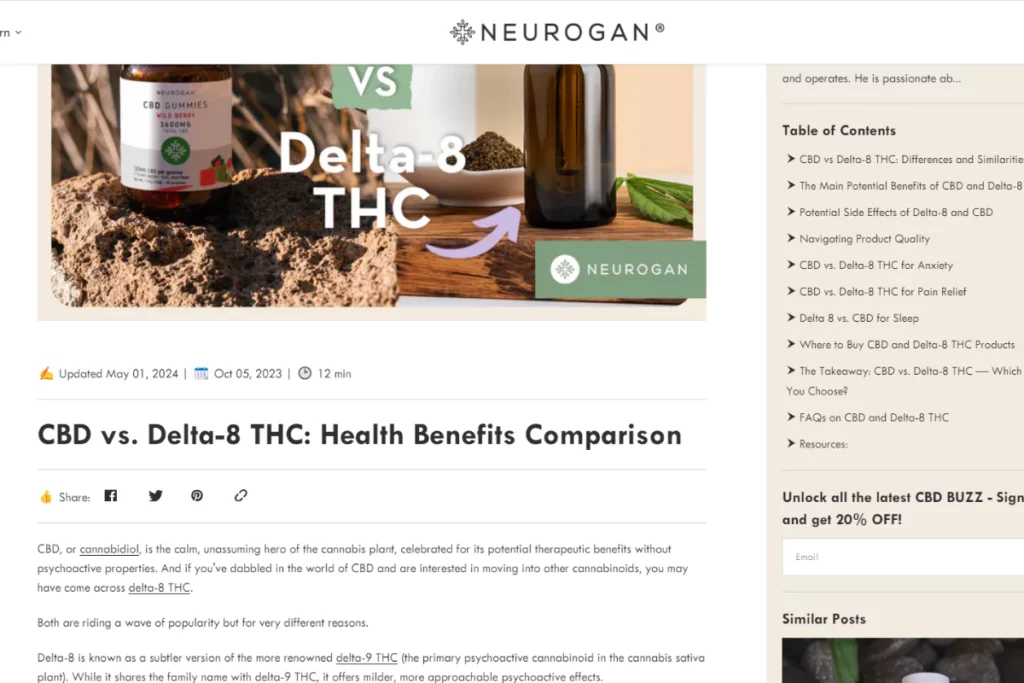
This article ranks #4 for “CBD vs delta 8,” a keyword that gets over 1,500 monthly searches.
Here are three things I love about Neurogan’s article:
- Comprehensiveness: The not-so-secret secret behind winning valuable rankings is creating an article that covers the target keyword comprehensively. Neurogan’s article does a good job of this by comparing CBD and delta 8 for their efficacy at addressing sleep, anxiety, and pain, instead of merely stopping at comparing the properties of these two cannabinoids.
- Research: Neurogan backs up their assertions with research on CBD and delta 8, which lends credibility to their article.
- Custom graphics: The featured image is custom, but Neurogan also created a comparison graphic between CBD and delta 8 specifically for this article. Their graphic provides an elegant visual summary of the main differences between these two cannabinoids.
2. Botanika Life: “Using CBD on Airplanes: Flight Anxiety & Other FAQs”

This article ranks #1 for “CBD for flight anxiety,” a keyword that gets 110 searches per month.
Here are three things I love about Botanika Life’s article:
- Topic choice: The keyword Botanika Life targets in this article gets just 110 searches per month, but it’s relatively-low competition. By strategically choosing this keyword and creating a high-quality piece of content that answers the search intent behind it, Botanika Life is able to rank #1 and capture the majority of the traffic from this term.
- Immediate answer: Botanika Life discusses CBD’s potential benefits for flight anxiety in the second paragraph of the article. Instead of requiring readers to spend their time scrolling to find the answer, Botanika Life answers the question right away.
- CTA: Botanika Life includes product widgets and in-text CTAs throughout the article. They’re relevant, and they’re not invasive or distracting. This allows Botanika to drive sales from readers without ruining the content experience for people who aren’t interested in purchasing their products.
3. CBD for Life: “How Does CBD Oil Make You Feel”
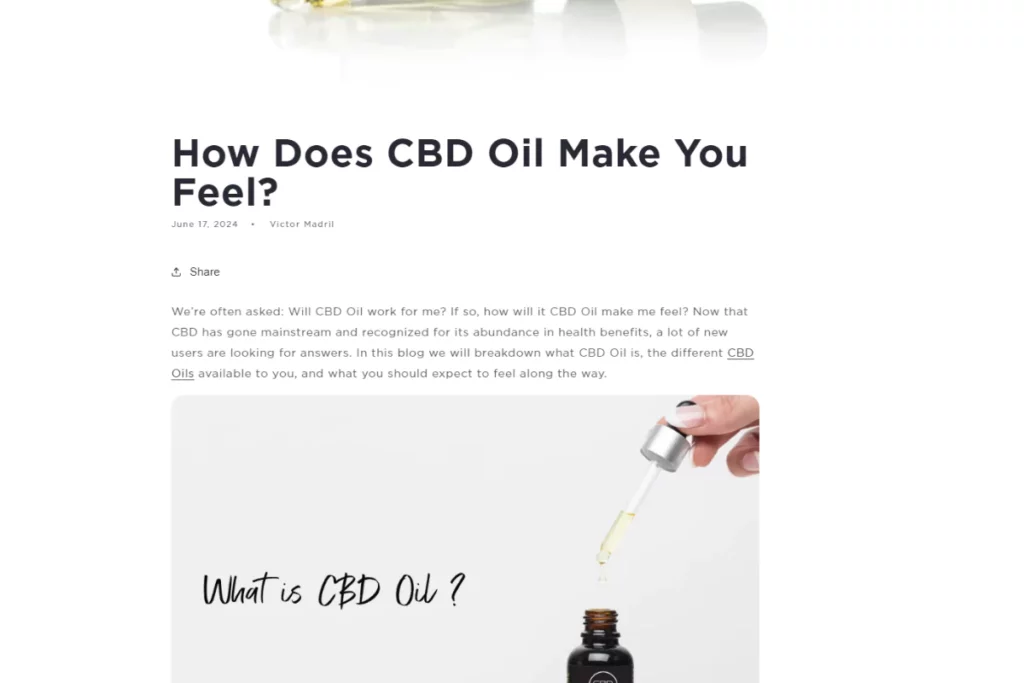
This article ranks #4 for “how does cbd make you feel,” a keyword that receives 2,400 searches per month.
Here are three things I love about CBD for Life’s article:
- Custom images: In their article, CBD For Life includes multiple images of people using their products. This doesn’t just provide visual context; it allows them to show off their brand in a natural, non-promotional way.
- Context: CBD For Life provides context for the benefits of CBD and how it works in the body. They don’t just tell you how CBD makes you feel; they explain why CBD makes you feel that way and the health impact it has.
- Buying guidance: In addition to providing the answer that people came for, CBD For Life offers guidance on the different types of CBD oil and how to choose between them.
Writing CBD Content That Drives Traffic and Turns Heads
You won’t get everything right the first time you set out to write content for your CBD brand.
But by following the correct process and understanding what is and isn’t important, you’ll be able to improve your skills and begin seeing results much quicker than if you trial-and-errored the entire thing.
That’s what I hope this article provided you: a starting place.
Before we end, I want to leave you with one question you should ask yourself each time you’re developing a new article: “If I were reading this article, what would I wish it had?”
Answer that question and implement your answer. Then do it again every time you write an article.
Soon, you’ll have a consistent flow of organic traffic, email signups, and sales, plus the topical authority you need to rank for the money-making terms.
Learn More About Our CBD Content Writing & SEO Services
We help cannabis, CBD, and other natural products brands grow their revenue with SEO, and content writing is a big part of how we do that.
The content we write drives hundreds of thousands of sessions per year for our clients and contributes to hundreds of thousands of dollars of revenue – and we do it using the process laid out above.
We’d love to help your business, too – whether directly or through our free resources:
- To work with us, visit our contact us page.
- To learn more about what we do, visit our CBD content writing services and CBD SEO services pages.
- To learn more about doing your own SEO, visit our blog.

